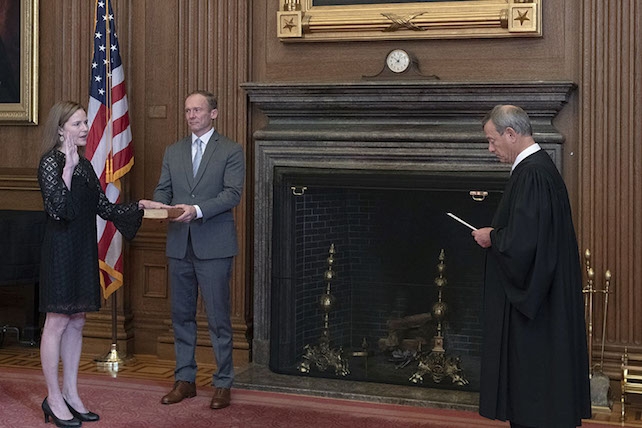At the U.S. Supreme Court this year, houses of worship are 0-for-2 so far in their efforts to seek exemptions from pandemic-related restrictions. That could change, however, now that Justice Amy Coney Barrett, a religious liberties advocate, has filled the seat of longtime liberal Justice Ruth Bader Ginsburg.
Yesterday, the Roman Catholic Diocese of Brooklyn asked SCOTUS to free its 26 churches from an executive order limiting the number of in-person worshipers. On October 6, as cases began rising throughout New York, Gov. Andrew Cuomo set zone-based rules that are stricter for churches than for some businesses. In red zones, where outbreaks are highest, churches are limited to 25 percent capacity or 10 people, whichever is fewer. In orange zones, the limit is 33 percent of capacity or 25 people. Only essential businesses, including grocery stores, are permitted to remain open in red zones. “High risk non-essential businesses” such as gyms and theaters must remain closed in both red and orange zones.
Diocese: Order is ‘spiritually harmful’
In mid-October, a U.S. District Court denied a preliminary injunction request that would have allowed the diocese more leeway to reopen churches. Judge Nicholas Garaufis ruled that although church personnel were taking safety precautions, “the enormity of the potential harm to the entire public, including to the parishioners of the 26 relevant churches is overwhelming.”
The diocese argued that its First Amendment right of religious expression was being violated and that state officials were discriminating against churches. Cuomo’s order, it said, places a “devastating and spiritually harmful burden on the Catholic community.” The diocese also argued that details about coronavirus transmission and safety practices are much clearer now than when the pandemic began. Because “circumstances have evolved,” it said, judges no longer need to defer to overreaching public health orders.
After the lower-court defeat, Bishop Nicholas DiMarzio indicated he would “continue to advocate for places of worship to be classified as essential, for there is nothing more necessary today than a community of believers, united in prayer, asking the Lord to end this pandemic.”
The diocese, which so far has remained COVID-free, requires masks and social distancing, and it caps attendance at 25 percent. It also has voluntarily shuttered churches in Brooklyn’s red zones, citing a desire to never turn away any worshipers. “It is unfortunate that our inalienable constitutional right to worship is still impeded despite the efforts we have made,” Bishop DiMarzio said in an October 16 statement.
SCOTUS Makeup Has Changed Since Previous Rulings
In May, the Supreme Court ruled 5-4 against a California church that was fighting shutdown orders. South Bay United Pentecostal Church near San Diego argued it was “just asking for the same rights and privileges every other enterprise has in the state.” But a majority—including Chief Justice John Roberts—ruled that courts shouldn’t overturn elected leaders’ decisions amid a pandemic, especially when “local officials are actively shaping their response to changing facts on the ground.” In a dissent, four conservative justices argued that California had failed to sufficiently explain why restrictions were tougher for churches than for businesses.
Two months later, SCOTUS denied a similar request from a Nevada church. Calvary Chapel Dayton Valley, east of Reno, argued that Gov. Steve Sisolak’s 50-person cap for worshipers discriminated against churches, while casinos and other businesses were allowed to operate at 50 percent capacity. In another 5-4 ruling, Roberts joined the liberal wing in deferring to local officials during a crisis.
Dissenting Justice Samuel Alito, however, wrote that “even a public health emergency” doesn’t absolve the court of its responsibility to defend rights. “The Constitution guarantees the free exercise of religion,” he wrote. “It says nothing about freedom to play craps or blackjack.” Alito added that while some “unprecedented restrictions on personal liberty” might have been “understandable” temporarily, leaders aren’t allowed “to disregard the Constitution for as long as the medical problem persists.”
Justice Ginsburg, who sided with the majority in both cases, died in September, allowing President Trump to appoint his third justice. During Barrett’s confirmation process last month, Trump called her key to “the survival” of “our religious freedom.”
After Chief Justice Roberts sided with liberal justices on recent religious-liberties cases, Vice President Mike Pence called him “a disappointment to conservatives.” Now that SCOTUS has another right-leaning member, religious-freedom advocates are hopeful about receiving a favorable ruling.

